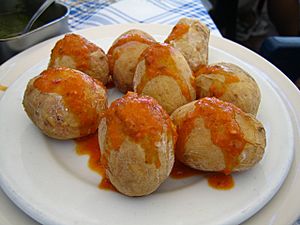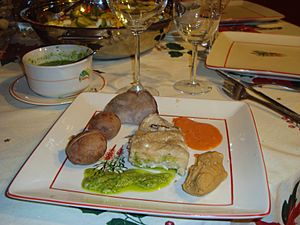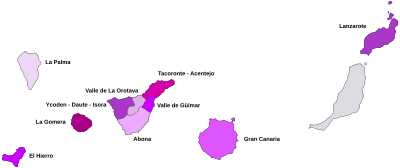Canarian cuisine facts for kids
Canarian cuisine is all about the yummy and fresh dishes from the Canary Islands. It's a big part of what makes the islands special! This food is known for being super fresh, simple, and full of amazing ingredients. It mixes seafood and meat dishes, showing off different cultures that have influenced it.
The food here has been shaped by the islands' first people, the Guanches, and also by Latin American cuisine. This is especially true because many Canarians moved to Latin America in the 1900s.
Contents
Sauces and Snacks
In the Canary Islands, people love to start their meals with small dishes called enyesques. These are like appetizers or snacks.
Mojo is a super famous sauce served with many dishes. It's made from oil, garlic, vinegar, salt, and spices like red pepper, thyme, cumin, and coriander. There are two main kinds:
- Mojo rojo (red mojo): This one is often served with meat.
- Mojo verde (green mojo): This one usually goes with fish.
Both can be eaten with potatoes. If the red mojo is spicy, it's called mojo picón. This sauce recipe even inspired many mojos in Latin America, especially in Cuba, Dominican Republic, Puerto Rico, and Venezuela.
Papas arrugadas means "wrinkly potatoes." They are small potatoes boiled in salty water with their skins on. They get a wrinkly look, and they are always served with mojo sauce.
A very special Canarian food is gofio. It's a type of flour made from grinding roasted sweetcorn. For hundreds of years, gofio was a main food for the people living on the islands. Today, it's still made locally and added to many dishes. You can mix it with warm milk for breakfast, or make it into a dough called pella to eat with meals. Another popular dish is gofio escaldado, where gofio is stirred into fish broth with onions.
The islands also have many kinds of delicious local cheese, especially goat cheese. Cheeses from La Palma and Fuerteventura are so special they have a protected label called "Denominación de Origen." Other well-known cheeses include Flor de Guía cheese and queso tierno (which means "tender cheese"). On La Gomera island, hard cheese is made into a paste called Almogrote. Sometimes, grilled cheese with mojo is served as a starter.
First Dishes
Traditional Canarian meals often begin with a warm soup. This helps get your stomach ready for the main course! Some of the most famous soups are:
- Potaje: This is a thick vegetable soup with potatoes. It's a popular way for Canarians to eat their veggies. The ingredients can change a lot depending on which island you are on. A favorite is potaje de berros (watercress soup). Sometimes, these soups are blended into smooth purees, which are great for younger kids.
- Caldo de papas (potato soup): A simple soup made mostly with potatoes and coriander.
- Caldo de pescado (fish soup): This soup usually has popular local fish like mero (grouper), sama (common dentex), and cherne (wreckfish).
- Rancho canario: This is a hearty soup with chickpeas, lard, thick noodles, potatoes, and meat.
Fish Dishes
The waters around the Canary Islands are full of many different kinds of fish. These fish can be cooked in lots of ways, like baked in the oven (sometimes covered in salt), fried, or marinated in tasty sauces. Here are a few examples:
- Sancocho canario: This dish features boiled fish with potatoes, sweet potatoes, gofio, and mojo. In Tenerife, it's often served in a pot.
- Pescado seco (dry fish): This includes dishes like tollos (strips of school shark served with sauce) and jareas (fish that are opened up and dried, similar to bacalhau). Jareas are often eaten roasted.
Meat Dishes
The most common meats eaten in the Canary Islands are pork, chicken, rabbit, and goat.
- Puchero canario: This is a rich meat soup, similar to other Spanish stews. It combines chicken, beef, and pork with chickpeas, corn on the cob, sweet potatoes, potatoes, and other vegetables like carrots and cabbage.
- Goat meat: People have been eating goat meat on the islands since before the Spanish arrived.
- Ropa vieja (meaning 'old clothes'): This dish mixes chicken and beef with potatoes and chickpeas. The Canarian ropa vieja is actually the original version that inspired the famous Cuban ropa vieja because of Canarian people moving there.
- Conejo en salmorejo: This is a traditional rabbit stew marinated in a special coriander sauce. It's not the same as the salmorejo sauce found in mainland Spain.
- Pork is used in dishes like carne fiesta (meaning 'party meat') and costillas con piña (ribs with corn on the cob).
Sweets and Desserts
Canarian desserts often use simple, natural ingredients like cane sugar, honey, anise, almonds, and traditional miel de palma (palm honey), especially from the island of La Palma. Some popular desserts include:
- Bienmesabe: This name means 'tastes good to me'! It's a sweet paste made from almonds, honey, and sugar. It's often served with ice cream or cream and cat's tongue cookies.
- Frangollo: A mix of corn flour, sugar, almonds, and raisins.
- Truchas: These are pastries filled with sweet potato paste or cabell d'angel (a sweet pumpkin jam). They are usually made around Christmastime.
On El Hierro island, there's a special cake called quesadilla which is made with cheese. Other sweet treats include rosquetes (ring-shaped fried pastries), quesillo (a tender cheese cake), rapaduras (cane sugar candy), Príncipe Alberto (a chocolate cake from La Palma), and leche asada (a baked milk cake). Gofio is also used in some desserts, like huevos mole, pella de gofio (a patty made of milk and gofio), and mousse de gofio (a creamy gofio dessert).
Even though they aren't originally from the islands, tropical fruits, especially bananas, are grown a lot and eaten everywhere in the Canary Islands.
Wines and Drinks
The wine made from the malvasia grape was a big export from the Canary Islands starting in the 1600s. Today, the islands produce ten types of wines that have special protected labels, meaning they come from specific areas and are made in a certain way. These Canarian "Denominación de Origen" wines include:
- Abona (Tenerife)
- Tacoronte-Acentejo (Tenerife)
- Valle de Güímar (Tenerife)
- Valle de La Orotava (Tenerife)
- Ycoden-Daute-Isora (Tenerife)
- El Hierro
- Lanzarote
- La Palma
- La Gomera
- Gran Canaria
While Licor 43 isn't made in the Canary Islands, it's a common ingredient in a popular drink called the barraquito or zaperoco. This is a layered drink made with Licor 43, coffee, condensed milk, and frothed milk.
See also
 In Spanish: Gastronomía de Canarias para niños
In Spanish: Gastronomía de Canarias para niños




